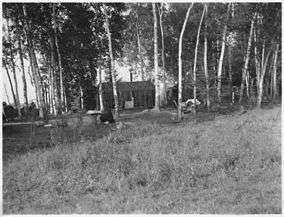Rice Lake National Wildlife Refuge
The 18,208-acre (73.69 km2) Rice Lake National Wildlife Refuge was established in 1935 and is located in the scenic forest and bog area of northern Minnesota. Visitors can enjoy a range of habitats, including lake, river, bog and hardwood forest.
| Rice Lake National Wildlife Refuge | |
|---|---|
IUCN category IV (habitat/species management area) | |
 Rice shacks on Big Rice Lake in 1937 | |
 Map of the United States | |
| Location | Aitkin County, Pine County, Minnesota, United States |
| Nearest city | McGregor, Minnesota |
| Coordinates | 46°31′51″N 93°20′15″W[1] |
| Area | 18,208 acres (73.69 km2) |
| Established | 1935 |
| Governing body | U.S. Fish and Wildlife Service |
| Website | Rice Lake National Wildlife Refuge |
The refuge's history centers around the 4,500-acre (18 km2) Rice Lake which, for thousands of years, has supplied an abundant wild rice crop. Each fall, the bountiful rice attracts hundreds of thousands of waterfowl, as well as American Indians who harvest it using traditional methods. Rice Lake is known for its tremendous number of ring-necked ducks. Because of the high concentrations of migratory birds, Rice Lake Refuge has been designated as a Globally Important Bird Area by the American Birding Association.
The 2,045-acre (8.28 km2) Sandstone Unit (at 46°05′30″N 92°50′16″W in Pine County) of Rice Lake National Wildlife Refuge was acquired in 1970 through a land exchange with the United States Department of Justice. Sandstone is located in central Minnesota, in an area once known for expanses of towering white pine forests. Today, visitors enjoy a rustic and natural setting that includes a portion of the Wild and Scenic Kettle River. Birders will find plentiful neo-tropical migrants in the spring and fall. Sandstone's wildlife includes black bear, sandhill cranes, white-tailed deer and songbirds.
The one-half-acre Mille Lacs National Wildlife Refuge, located in Mille Lacs Lake, is also administered from Rice Lake Refuge.
References
![]()